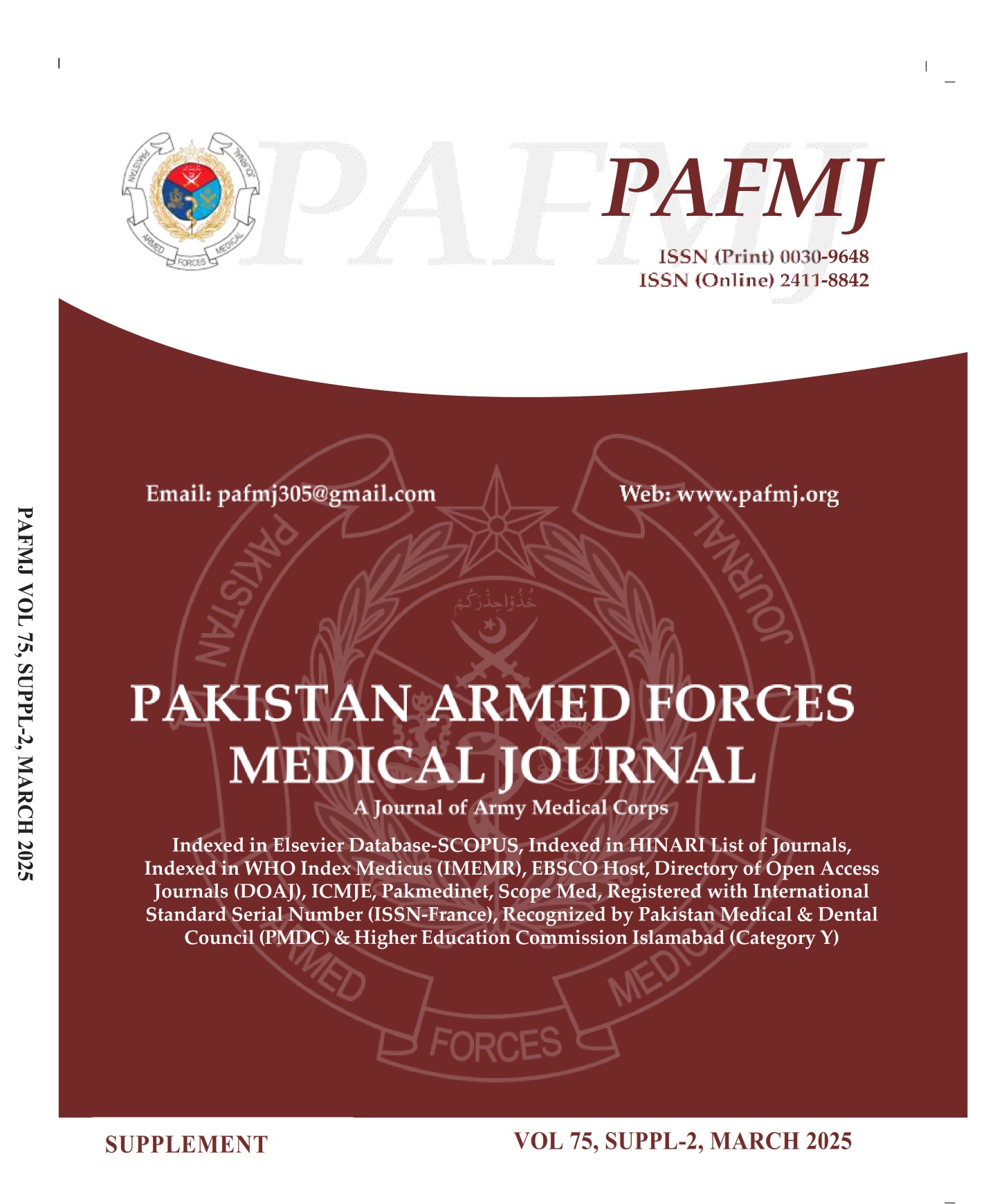Negative Pressure Wound Therapy in Lower Limb Reconstruction
DOI:
https://doi.org/10.51253/pafmj.v75iSUPPL-2.7235Keywords:
Lower Limb Reconstruction, Negative Pressure Wound Therapy (Npwt), Wound Outcomes of Negative Pressure, Wound Therapy in Lower Limb ReconstructionAbstract
Objective: To access the efficacy of negative pressure wound therapy and, its potential outcomes in lower limb reconstruction.
Study Design: Prospective observational study.
Place and Duration of Study: Department of Plastic Surgery, Combined Military Hospital, Rawalpindi Pakistan, from Dec 2019 to Dec 2020.
Methodology: We evaluated negative pressure wound therapy on 56 patients meeting exclusion and inclusion criteria. Dressing kept for 03 to 04 days on continuous suction pressure at -125 mmHg. Outcomes measured in term of wound size reduction, type of tissue requirement for wound coverage and complications after negative pressure wound therapy.
Result: Wound size reduction after negative pressure wound therapy was 24.10% with average number of dressings 02.39±1.07 (range 01 to 06) Wound covered with Partial Thickness Skin Graft in 38(67.9%) patients. Flap coverage required in 15(26.8%) in lower limb. No major complication noted in 56 patients.
Conclusion: Negative pressure wound therapy has evolved management algorithm of complex and complicated wounds in lower extremities. It optimizes wound bed, significantly reduces duration of wound healing and lessen soft tissue defect coverage with secondary procedures.
Downloads
References
Orgill DP, Bayer LR. Update on negative-pressure wound therapy. Plast Reconstr Surg 2011; 127(1): 105S-115S. https://doi.org/10.1097/PRS.0b013e318200a427
Attia A, Elmenoufy T, Atta T, Harfoush A, Tarek S. Combination of negative pressure wound therapy (NPWT) and integra dermal regeneration template (IDRT) in the lower extremity wound; Our experience with 4 cases. JPRAS Open 2020; 24(3): 32-39. https://doi.org/10.1016/j.jpra.2020.03.004
Singh D, Chopra K, Sabino J, Brown E. Practical things you should know about wound healing and vacuum-assisted closure management. Plast Reconstr Surg 2020; 145(4): 839e-854e.
https://doi.org/10.1097/PRS.0000000000006652
Glass GE, Murphy GR, Nanchahal J. Does negative-pressure wound therapy influence subjacent bacterial growth? A systematic review.J Plast Reconstr Aesthet Surg 2017; 70(8): 1028-1037.
https://doi.org/ 10.1016/j.bjps.2017.05.027
Sirisena R, Bellot GL, Puhaindran ME. The role of negative-pressure wound therapy in lower-limb reconstruction. Indian J Plast Surg 2019; 52(01): 073-80.
Poteet SJ, Schulz SA, Povoski SP, Chao AH. Negative pressure wound therapy: device design, indications, and the evidence supporting its use. Expert Rev Med Devices 2021; 18(2): 151-160.
Eginton MT, Brown KR, Seabrook GR, Towne JB, Cambria RA, et al. A prospective randomized evaluation of negative-pressure wound dressings for diabetic foot wounds. Ann Vasc Surg 2003; 17(6): 645-649.
Lee HJ, Kim JW, Oh CW, Min WK, Shon OJ, Oh JK, et al. Negative pressure wound therapy for soft tissue injuries around the foot and ankle. J Orthop Surg Res 2009; 4(1): 1-5.
Li J, Wang Q, Lu Y, Feng Q, He X, Li, et al. Relationship between time to surgical debridement and the incidence of infection in patients with open tibial fractures. Orthop Surg 2020; 12(2): 524-532.
Parrett BM, Matros E, Pribaz JJ, Orgill DP. Lower extremity trauma: trends in the management of soft-tissue reconstruction of open tibia-fibula fractures. Plast Reconstr Surg 2006; 117(4): 1315-1322.
DeFranzo AJ, Argenta LC, Marks MW, Molnar JA, David LR, Webb LX, et al. The use of vacuum-assisted closure therapy for the treatment of lower-extremity wounds with exposed bone. Plast Reconstr Surg 2001; 108(5): 1184-1191.
Lavery LA, Barnes SA, Keith MS, Seaman JW, Armstrong DG. Prediction of healing for postoperative diabetic foot wounds based on early wound area progression. Diabetes Care 2008; 31(1): 26-29.
Frykberg RG, Williams DV. Negative-pressure wound therapy and diabetic foot amputations: a retrospective study of payer claims data. J Am Podiatr Med Ass 2007; 97(5): 351-359.
Yin Y, Zhang R, Li S, Guo J, Hou Z, Zhang Y, et al. Negative-pressure therapy versus conventional therapy on split-thickness skin graft: a systematic review and meta-analysis. Int J Surg 2018; 50: 43-48.
Petkar KS, Dhanraj P, Kingsly PM, Sreekar H, Lakshmanarao A, Lamba S, et al. A prospective randomized controlled trial comparing negative pressure dressing and conventional dressing methods on split-thickness skin grafts in burned patients. Burns 2011; 37(6): 925-929.
Baharestani MM, Houliston-Otto DB, Barnes S. Early versus late initiation of negative pressure wound therapy: examining the impact on home care length of stay. Ostomy Wound Manage 2008; 54(11): 48-53.
Dorafshar AH, Franczyk M, Gottlieb LJ, Wroblewski KE, Lohman R, F, et al. A prospective randomized trial comparing subatmospheric wound therapy with a sealed gauze dressing and the standard vacuum-assisted closure device. Ann Plast Surg 2012; 69(1): 79-84.
Robert N. Negative pressure wound therapy in orthopaedic surgery. Orthop Traumatol Surg Res 2017; 103(1): S99-103.
Desai KK, Hahn E, Pulikkotill B, Lee E. Negative pressure wound therapy: an algorithm. Clin Plast Surg 2012; 39(3): 311-324.
Kantak NA, Mistry R, Varon DE, Halvorson. Negative Pressure Wound Therapy for Burns. Clin Plast Surg 2017; 44(3): 671-677.
Khurram MF, Sarfraz Ali S, Yaseen M, et al. Vacuum-assisted wound closure therapy in pediatric lower limb trauma. Int J low Extrem Wounds 2019; 18(3): 317-322.
Rentea RM, Somers KK, Cassidy L, Enters J, Arca MJ. Negative pressure wound therapy in infants and children: a single-institution experience. J Surg Res 2013; 184(1): 658-664.
Oreja SG, González-Moncayo JN, Corbalán IS, Morales EG, Afonso FJ, Martínez JL, et al. Complications associated with the negative pressure therapy in the treatment of the diabetic foot ulcers: Retrospective case series. Rev.esp.podol 2017; 28(2): e27-31.
Rasool A, Bashir SA, Ahmad PA, Bijli AH, Baba UF, Yasir M,et al. Management of Wounds with Exposed Bones or Tendons in Children by Vacuum-Assisted Closure Therapy: A Prospective Study. Indian J Plast Surg 2020; 53(01): 097-104
Downloads
Published
Issue
Section
License
Copyright (c) 2025 Afia Ayub, Shahid Hameed Choudhary, Abdul Majid, Palwasha Mansoor, Muhammad Umer Qureshi, Shah Faisal

This work is licensed under a Creative Commons Attribution-NonCommercial 4.0 International License.















